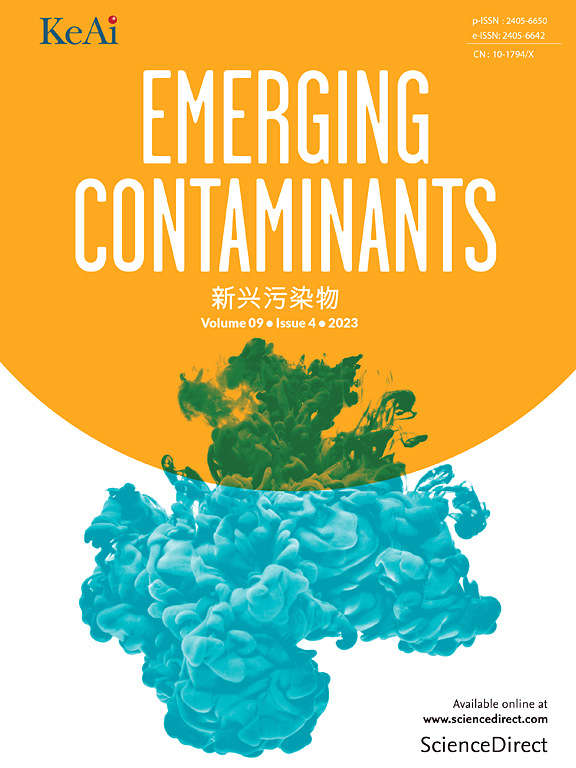PFAS residue analysis in fish and fish feed by applying a modified QuEChERS method in combination with LC-HRMS detection
IF 5.3
2区 环境科学与生态学
Q1 ENVIRONMENTAL SCIENCES
引用次数: 0
Abstract
A targeted method for the quantitative determination of PFAS residues in fish feed and marine aquaculture fish species was developed and validated in the current study. This method combines a modified QuEChERS extraction methodology that includes sonication followed by Liquid Chromatography- Linear Ion Trap/Orbitrap High Resolution Mass Spectrometry (LC- LTQ/Orbitrap HRMS) analysis. The original QuEChERS method was selected with some modifications and the clean-up step was performed using Enhanced Matrix Removal-Lipid (EMR-Lipid) as the dispersive solid-phase extraction (dSPE) agent. The optimization of the sample preparation included different sorbents in the clean-up step for the fish feed matrix, and various sample amounts and sonication treatment times were tested for both matrices. The optimized modified extraction procedure for the analysis of PFAS residues in fish feed was fully validated exhibiting recoveries between 51.1 % and 101.2 %, relative standard deviations (RSDs) < 20.7 % and LOQs between 0.03 ng/g and 0.50 ng/g. Furthermore, the current study provides validation data for the analysis of PFAS residues in fish tissues according to the analytical method proposed for PFAS analysis in fish feed, with linearity values ≥ 0.9901, recoveries ranging from 55.5 to 113.3 % and precision values < 20.0 % (%RSD). Matrix effect studies demonstrated low, and medium values and the method showed an acceptable expanded uncertainty of <57.66 %. Finally, the modified method was applied to analyze fish and fish feed samples from Greek aquaculture facilities. No PFAS residues were detected in any of the fish samples, whereas two fish feeds contained PFOS residues and one contained the target PFOA.

应用改进的QuEChERS法结合LC-HRMS法分析鱼及鱼饲料中PFAS残留
本研究建立了一种针对性的定量测定鱼饲料和海洋养殖鱼类中PFAS残留的方法,并进行了验证。该方法结合了改进的QuEChERS提取方法,包括超声,然后是液相色谱-线性离子阱/轨道rap高分辨率质谱(LC- LTQ/Orbitrap HRMS)分析。选择原始的QuEChERS方法,并对其进行一些修改,采用Enhanced Matrix removal -脂质(emr -脂质)作为分散固相萃取(dSPE)剂进行清理步骤。样品制备的优化包括在鱼饲料基质的清理步骤中使用不同的吸附剂,并对两种基质进行了不同的样品量和超声处理时间的测试。优化后的改良提取工艺可用于鱼饲料中PFAS残留的分析,其回收率在51.1% ~ 101.2%之间,相对标准偏差(rsd)为;loq在0.03 ~ 0.50 ng/g之间。此外,本研究根据提出的鱼饲料中PFAS分析方法为鱼组织中PFAS残留分析提供了验证数据,线性值≥0.9901,回收率为55.5% ~ 113.3%,精密度值为<;20.0% (% rsd)。基质效应研究显示出低、中值,该方法的扩展不确定度为<; 57.66%。最后,将改进后的方法应用于希腊水产养殖设施的鱼和鱼饲料样品的分析。在任何鱼类样本中均未检测到全氟辛烷磺酸残留,而两种鱼类饲料含有全氟辛烷磺酸残留,一种含有目标全氟辛烷磺酸。
本文章由计算机程序翻译,如有差异,请以英文原文为准。
求助全文
约1分钟内获得全文
求助全文
来源期刊

Emerging Contaminants
Medicine-Public Health, Environmental and Occupational Health
CiteScore
10.00
自引率
6.70%
发文量
35
审稿时长
44 days
期刊介绍:
Emerging Contaminants is an outlet for world-leading research addressing problems associated with environmental contamination caused by emerging contaminants and their solutions. Emerging contaminants are defined as chemicals that are not currently (or have been only recently) regulated and about which there exist concerns regarding their impact on human or ecological health. Examples of emerging contaminants include disinfection by-products, pharmaceutical and personal care products, persistent organic chemicals, and mercury etc. as well as their degradation products. We encourage papers addressing science that facilitates greater understanding of the nature, extent, and impacts of the presence of emerging contaminants in the environment; technology that exploits original principles to reduce and control their environmental presence; as well as the development, implementation and efficacy of national and international policies to protect human health and the environment from emerging contaminants.
 求助内容:
求助内容: 应助结果提醒方式:
应助结果提醒方式:


